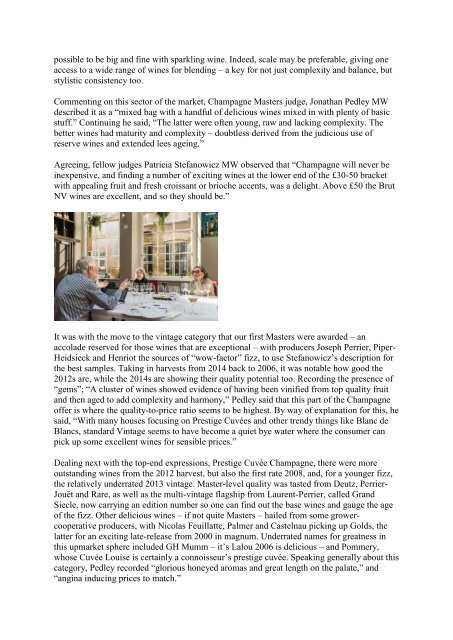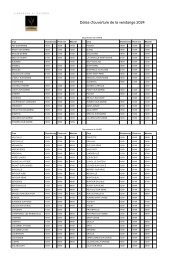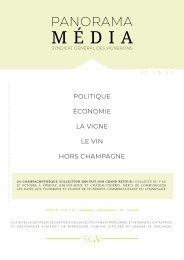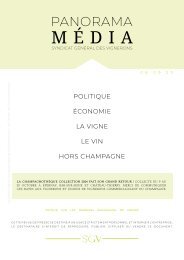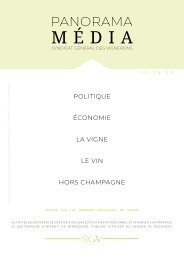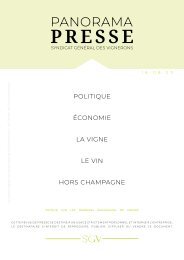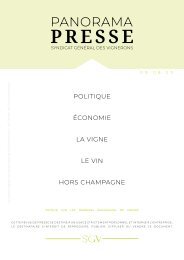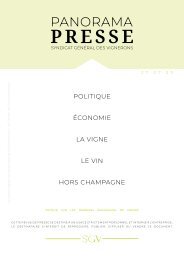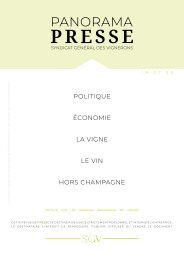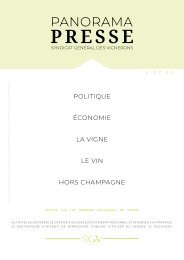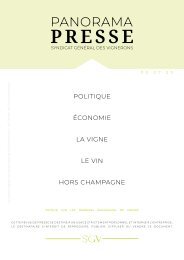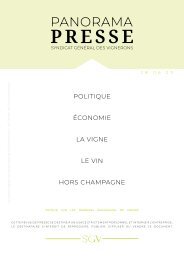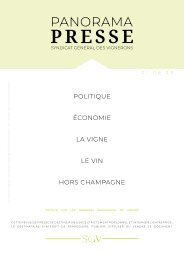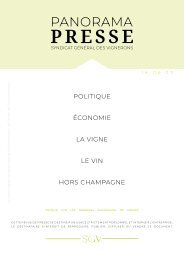Panorama de presse quotidien du 02 07 2022
Create successful ePaper yourself
Turn your PDF publications into a flip-book with our unique Google optimized e-Paper software.
possible to be big and fine with sparkling wine. In<strong>de</strong>ed, scale may be preferable, giving one<br />
access to a wi<strong>de</strong> range of wines for blending – a key for not just complexity and balance, but<br />
stylistic consistency too.<br />
Commenting on this sector of the market, Champagne Masters judge, Jonathan Pedley MW<br />
<strong>de</strong>scribed it as a “mixed bag with a handful of <strong>de</strong>licious wines mixed in with plenty of basic<br />
stuff.” Continuing he said, “The latter were often young, raw and lacking complexity. The<br />
better wines had maturity and complexity – doubtless <strong>de</strong>rived from the judicious use of<br />
reserve wines and exten<strong>de</strong>d lees ageing.”<br />
Agreeing, fellow judges Patricia Stefanowicz MW observed that “Champagne will never be<br />
inexpensive, and finding a number of exciting wines at the lower end of the £30-50 bracket<br />
with appealing fruit and fresh croissant or brioche accents, was a <strong>de</strong>light. Above £50 the Brut<br />
NV wines are excellent, and so they should be.”<br />
It was with the move to the vintage category that our first Masters were awar<strong>de</strong>d – an<br />
accola<strong>de</strong> reserved for those wines that are exceptional – with pro<strong>du</strong>cers Joseph Perrier, Piper-<br />
Heidsieck and Henriot the sources of “wow-factor” fizz, to use Stefanowicz’s <strong>de</strong>scription for<br />
the best samples. Taking in harvests from 2014 back to 2006, it was notable how good the<br />
2012s are, while the 2014s are showing their quality potential too. Recording the presence of<br />
“gems”; “A cluster of wines showed evi<strong>de</strong>nce of having been vinified from top quality fruit<br />
and then aged to add complexity and harmony,” Pedley said that this part of the Champagne<br />
offer is where the quality-to-price ratio seems to be highest. By way of explanation for this, he<br />
said, “With many houses focusing on Prestige Cuvées and other trendy things like Blanc <strong>de</strong><br />
Blancs, standard Vintage seems to have become a quiet bye water where the consumer can<br />
pick up some excellent wines for sensible prices.”<br />
Dealing next with the top-end expressions, Prestige Cuvée Champagne, there were more<br />
outstanding wines from the 2012 harvest, but also the first rate 2008, and, for a younger fizz,<br />
the relatively un<strong>de</strong>rrated 2013 vintage. Master-level quality was tasted from Deutz, Perrier-<br />
Jouët and Rare, as well as the multi-vintage flagship from Laurent-Perrier, called Grand<br />
Siecle, now carrying an edition number so one can find out the base wines and gauge the age<br />
of the fizz. Other <strong>de</strong>licious wines – if not quite Masters – hailed from some growercooperative<br />
pro<strong>du</strong>cers, with Nicolas Feuillatte, Palmer and Castelnau picking up Golds, the<br />
latter for an exciting late-release from 2000 in magnum. Un<strong>de</strong>rrated names for greatness in<br />
this upmarket sphere inclu<strong>de</strong>d GH Mumm – it’s Lalou 2006 is <strong>de</strong>licious – and Pommery,<br />
whose Cuvée Louise is certainly a connoisseur’s prestige cuvée. Speaking generally about this<br />
category, Pedley recor<strong>de</strong>d “glorious honeyed aromas and great length on the palate,” and<br />
“angina in<strong>du</strong>cing prices to match.”


